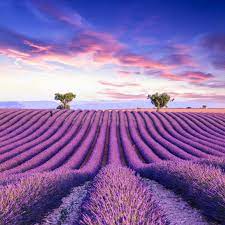 CAA Trip to Southern France and Monaco: May 5-10
CAA Trip to Southern France and Monaco: May 5-10
Travelogue & Pictures PART ONE | PART TWO
SUNDAY, MAY 5: AVIGNON AND CHÂTEAUNEUF-DU-PAPE (Text and photos by Janin Campos)
After an excellent breakfast at our hotel, Domaine des Escaunes in Sernhac, we set out at 9.30 am on the coach to Avignon for the day.
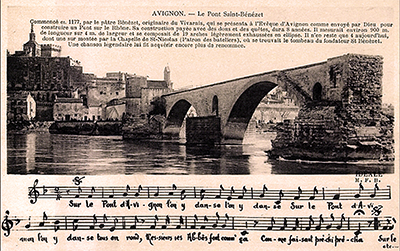 During our ride, our guide, Wolf, gave us a brief history of the Avignon Papacy. Following the death of Pope Benedict XI, the French King Philip IV forced a deadlocked conclave to elect the French Clement V as pope in 1305. Clement refused to move to Rome, and in 1309 he moved his court to the papal enclave at Avignon, where it remained until 1376, spanning the rule of seven popes. Wolf also talked about the Pont d’Avignon, playing us the famous rhyme taught to children, which many of us were able to sing along to.
During our ride, our guide, Wolf, gave us a brief history of the Avignon Papacy. Following the death of Pope Benedict XI, the French King Philip IV forced a deadlocked conclave to elect the French Clement V as pope in 1305. Clement refused to move to Rome, and in 1309 he moved his court to the papal enclave at Avignon, where it remained until 1376, spanning the rule of seven popes. Wolf also talked about the Pont d’Avignon, playing us the famous rhyme taught to children, which many of us were able to sing along to.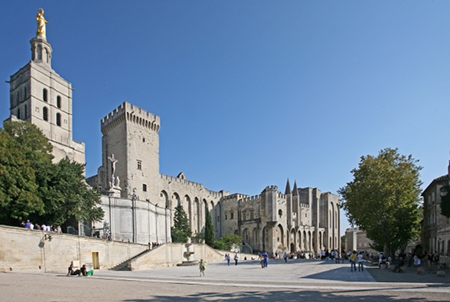 We visited the Palace of the Popes, the largest Gothic construction of the Middle Ages, including the cathedral and the papal library. When the papacy returned to Rome, the palace became obsolete and went into ruin. It was transformed into a garrison in 1906 for a while. It has since gone through various restoration phases.
We visited the Palace of the Popes, the largest Gothic construction of the Middle Ages, including the cathedral and the papal library. When the papacy returned to Rome, the palace became obsolete and went into ruin. It was transformed into a garrison in 1906 for a while. It has since gone through various restoration phases.Lunch was organized for us at a restaurant in one of the main promenades near the palace, where we had a choice of lamb stew or cod and chocolate mousse or creme brûlée.
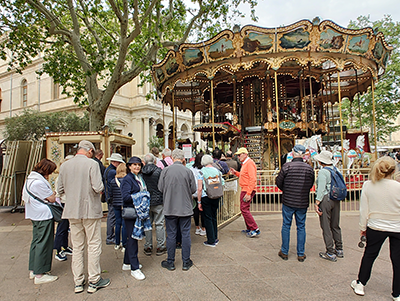 After, Wolfgang Fenkart-Fröschl bought tickets for the group to take a joyful ride on a carousel near the restaurant. Many of the locals and visitors must have found it odd to see an elderly group taking over the entire carousel, with glee on their faces like children as they spun around in the carousel. (Photo right by Bob Mitchell)
After, Wolfgang Fenkart-Fröschl bought tickets for the group to take a joyful ride on a carousel near the restaurant. Many of the locals and visitors must have found it odd to see an elderly group taking over the entire carousel, with glee on their faces like children as they spun around in the carousel. (Photo right by Bob Mitchell)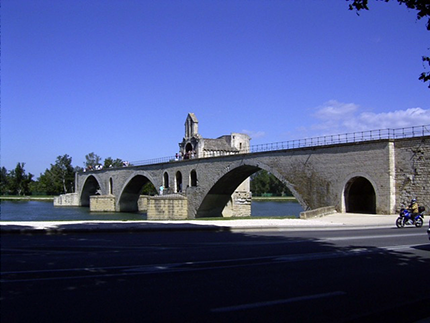 We walked back to our coach, from where we had a wonderful view of the Pont d’Avignon.
We walked back to our coach, from where we had a wonderful view of the Pont d’Avignon.In the afternoon, the coach took us to the right bank of the Rhône River to Villeneuf-les-Avignon where a number of us climbed to the top of the tower of King Philippe Le Belle with its spectacular 360 degree views including the golden dome of the cathedral and towers of Avignon in the distance.
We spent the late afternoon at our hotel free to stroll the surrounding gardens and the small village of Sernhac. Before dinner, we played a game of boule or pétanque. The competition involved a match of the men against the women, the ladies taking the victory by a small margin. (Pétanque photo by Bob Mitchell)
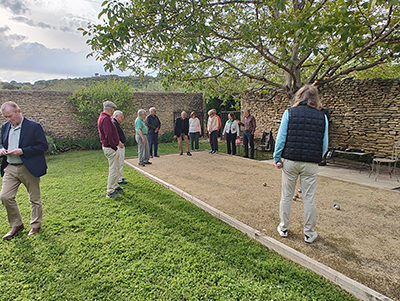

Before dinner Marc, the hotel proprietor, kindly served us champagne on the lawn following which we went for our dinner : asparagus with herbs and parmesan with a delicately poached egg on top, followed by cod in a sauce with vegetables, and a chocolate fondant for desert. After dinner, some took the opportunity to withdraw to the salon and enjoy a drink and chat into the late night.
(Photo right by Bob Mitchell: Myriam Bechter,
Diane Campos,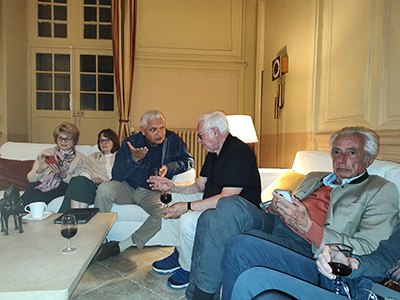 Janin Campos, Wolfgang Fenkart-Fröschl, Eberhard von Wangenheim
Janin Campos, Wolfgang Fenkart-Fröschl, Eberhard von Wangenheim
Diane Campos,
 Janin Campos, Wolfgang Fenkart-Fröschl, Eberhard von Wangenheim
Janin Campos, Wolfgang Fenkart-Fröschl, Eberhard von Wangenheim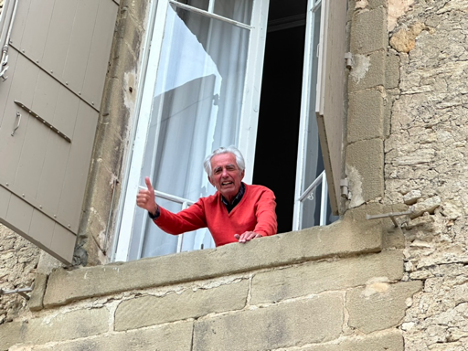
MONDAY, MAY 6, 2024: PONT DE GARD, ORANGE, UZES (Text and photos by Paul Brandow)
After a welcoming wave from Eberhard’s room (photo above) and the exhausting Pétanque competition of the previous afternoon, we awoke to find evidence of rain overnight and a slight drizzle on our departure, but that did not detract from another wonderful breakfast. The strawberries were beyond delicious.
Then it was off to Pont de Gard. On the way we received another of Wolf’s entertaining and informative commentaries. This time we heard the unlikely tale of how the Crusades turned pepper into a high-cost luxury item. It seems that organizers of the Fourth Crusade thought it a brilliant idea to use boats as a means of transport and convinced the Venetians to build them. Quel dommage, they were wildly optimistic about Crusader participation and commissioned way too many boats for which they couldn’t pay. Another brilliant idea followed, to compensate the Venetians with the spoils of the first pillage. Many pillages later and after the concession of much territory to the Venetians (the boats apparently being very expensive), the fortunate Venetians wound up with a monopoly on trade between Constantinople and Europe. Price distortions ensued, as they would in a monopoly, no more so than with pepper, which the Venetians turned into an expensive indulgence of European society, and in doing so enriched themselves immensely.
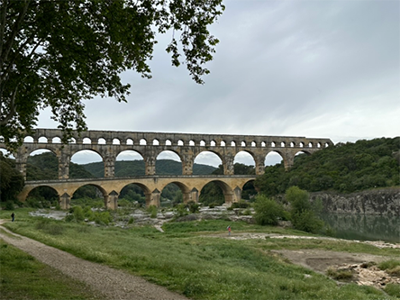 The Pont de Gard (left) was no less compelling. One of the best preserved examples of a Roman aqueduct (although Segovia in Spain may be the prize winner), we learned about the ingenious construction techniques (including wet sand and vines to do the cutting) and the clever design that controlled the ebb and flow of water over 30 miles. On the way out of the site, Wolf contrasted the elegant design of the first century aqueduct with the ugliness of the 20th century visitors center. Quel dommage again.
The Pont de Gard (left) was no less compelling. One of the best preserved examples of a Roman aqueduct (although Segovia in Spain may be the prize winner), we learned about the ingenious construction techniques (including wet sand and vines to do the cutting) and the clever design that controlled the ebb and flow of water over 30 miles. On the way out of the site, Wolf contrasted the elegant design of the first century aqueduct with the ugliness of the 20th century visitors center. Quel dommage again. On the way to Orange, our next stop, we learned about early Renaissance writers and poets. Dante (among other things a linguist who promoted High Italian), Boccaccio (credited with writing the first novel) and Petrarca/Petrarch (a humanist and very picky about this travelling companions) were part of this afternoon’s lesson. 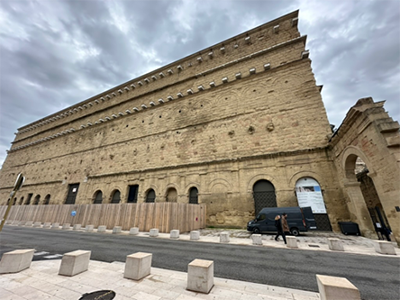 We had to be impressed by the theater in Orange (right), still a site for operas and other performances during the summer. The exterior wall was particularly impressive. We learned about seating priorities, the length of performances, the lack of costumes (masks would suffice), the reason theaters were at the perimeters of towns and a little about hooligans.
We had to be impressed by the theater in Orange (right), still a site for operas and other performances during the summer. The exterior wall was particularly impressive. We learned about seating priorities, the length of performances, the lack of costumes (masks would suffice), the reason theaters were at the perimeters of towns and a little about hooligans.

Lunch was a tasty bull goulash (don’t be put off by the name) and a nice local red wine in a comfortable, inviting restaurant.
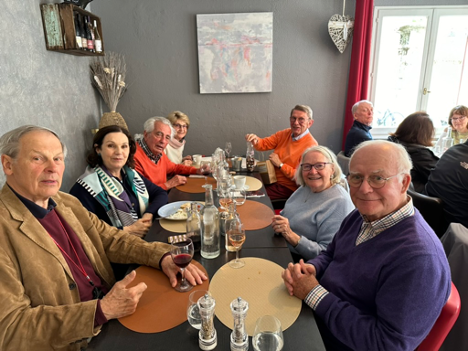
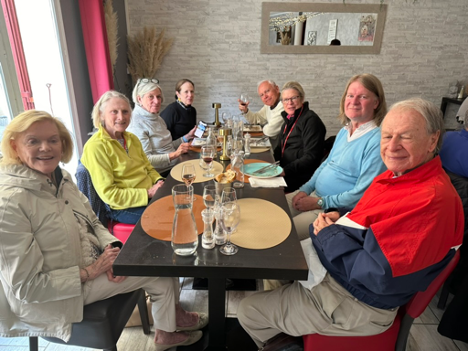
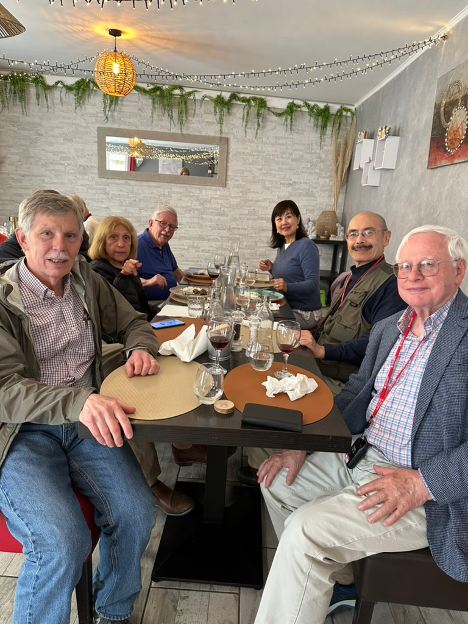
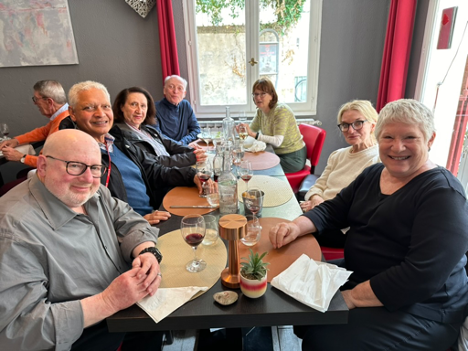
After lunch, it was on to Uzes. As rain began to fall, we received a small lecture on the calendar gymnastics of the Roman Senate, and then we arrived at one of the prettiest towns (there seem to be a lot of them) in Provence. We strolled through the old town where some explored the nice shops lining the narrow streets while others stopped at La Fontaine in the main square for coffee, cocoa or wine. We almost lost Denise and Katie Ward in the maze of the old town, but they made it back to the bus for our return to the hotel for a wine tasting and another nice dinner (if it’s not veau, it's lamb, if not sea bream, cod).
With plenty of wine included – red, white, rose? All three?
(Photos of Uzes by Norman Buchan) (Photos of wine tasting by Paul Brandow and Kathy Jiang)
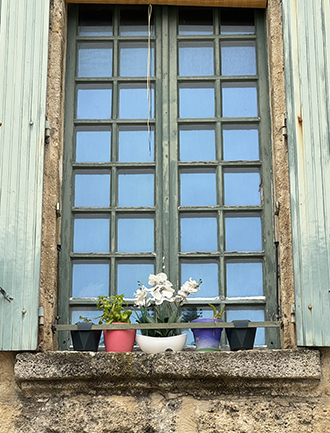
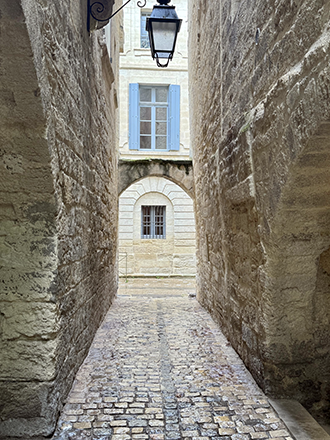

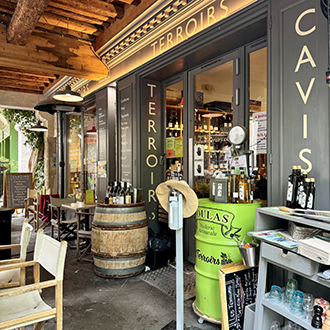
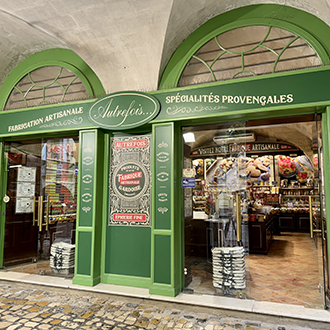
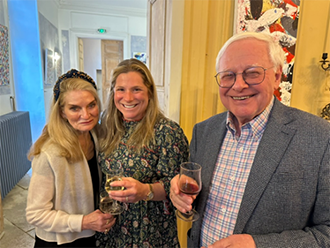
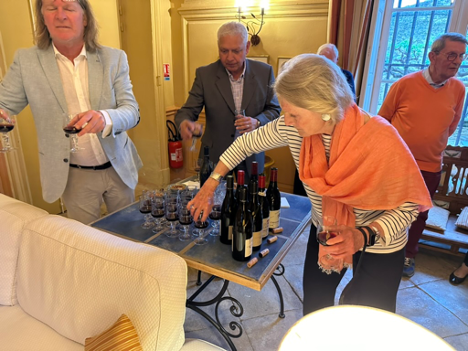
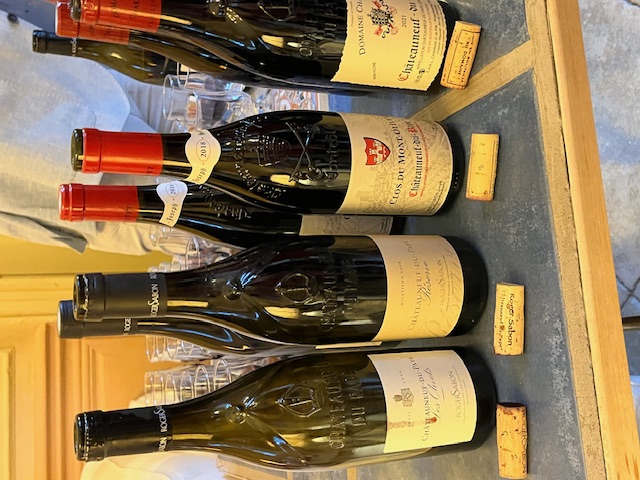
TUESDAY, MAY 7, 2024: ARLES AND THE ALPILLES MOUNTAINS (Text and photos by Bob Mitchell)
Another beautiful day in Provence. Breakfast, as always, very pleasant and satisfying with all the usuals plus fresh squeezed orange juice. in one of the ‘stone’ chambers of the delightful old coaching inn. Always an ear cocked to hear the jingle of horse bells as today’s post coach arrived at this way station.
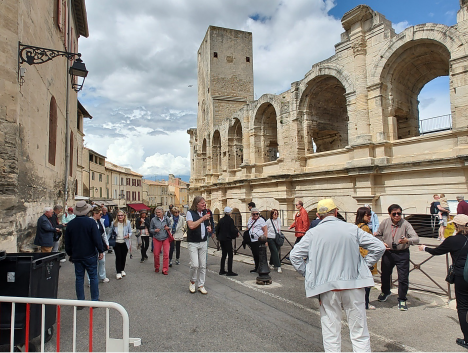 Then off again on our trusty (motor) coach for today’s adventures. Our first stop was the bustling town of Arles. As elsewhere in Provence, we toured one of the town’s main attractions of olden times – the ubiquitous Roman amphitheater. They never get old, and Wolf gave us a history and archaeology lesson on the construction and use of such entertainment ‘palaces’. One point: no ceiling, so performances were rain or shine, though how many came in the rain is not clear.
Then off again on our trusty (motor) coach for today’s adventures. Our first stop was the bustling town of Arles. As elsewhere in Provence, we toured one of the town’s main attractions of olden times – the ubiquitous Roman amphitheater. They never get old, and Wolf gave us a history and archaeology lesson on the construction and use of such entertainment ‘palaces’. One point: no ceiling, so performances were rain or shine, though how many came in the rain is not clear.After the amphitheater, we strolled the streets of the charming town, pausing to reflect on the café where Van Gogh gained inspiration on his sojourn here with his ‘friend’ Paul Cezanne. (Unfortunately, the café, along with Van Gogh’s residence and the famous oft-painted bridge, are now reconstructions since the originals were victims of the War.)
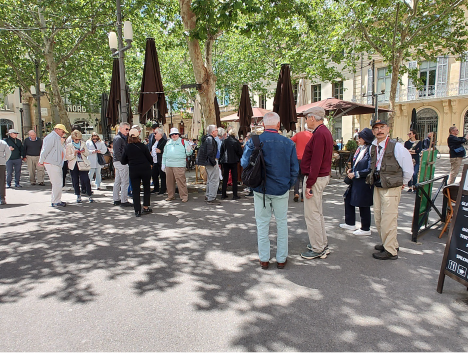 Lunch at one of the most delightful restaurants of the trip: L’Arlatan, in the heart of Arles. A wonderful meal of asperges, sauce Maltaise, roti de veau, panis et legumes and brioche perdue à l’ananas. Yum!
Lunch at one of the most delightful restaurants of the trip: L’Arlatan, in the heart of Arles. A wonderful meal of asperges, sauce Maltaise, roti de veau, panis et legumes and brioche perdue à l’ananas. Yum!After lunch we toured the Church of Saint Trophime, with another lesson from Wolf on church design. We passed the ubiquitous carousel in the town square (no ride for us this time). Then a hurried remount of our bus in the middle of a busy downtown street – and off for a pleasant ride through the countryside. We saw vineyards, orchards, mountains, cypresses and plane trees on the way to the small, but charming, Alpilles Mountains. Wolf pointed out the town of Les-Baux-de Provence and the excavation site of Les Baux, the forerunner of the bauxite and aluminum industry.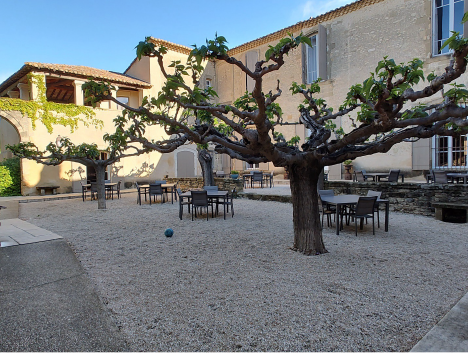

Then the final evening in Sernhac in the delightful Domaine des Escaunes, with dinner followed by cocktails and conversation in the lounge with our friends (aided by the fact that we had the whole hotel!). Here is a photo of the mulberry tree at the center of the hotel's courtyard.
WEDNESDAY, MAY 8, 2024: SENANQUE, PONT JULIEN, ROUSSILLON TO AIX
(Text and Photos by Toni Geyelin and Claire Irving)
Our eighth day got spun around, as a landslide blocked the road to what-would-have-been our first stop at L’Abbaye de Senanque. Our original destination in Senanque is the only one of the three original abbeys that is still home to monks. Fortunately, there are two other Cistercian abbeys in the region, so instead we visited L’Abbaye de Silvacane in Bouches de Rhone, which borders the Durance river.
The abbey was originally built by the Benedictine order but was taken over by Cistercian monks in 1144. The building is laid out identically to its two sister abbeys and maintained the stark, no frills décor to focus attention on labor, both physical and intellectual, and devotion. Only in the 15th century was a Gothic-style refectory added along with stained glass windows that would never have passed muster with the earlier inhabitants. An interesting feature of this abbey was a fish tank, measuring roughly 100’x3’x4’, where the monks kept their fresh fish for meals.
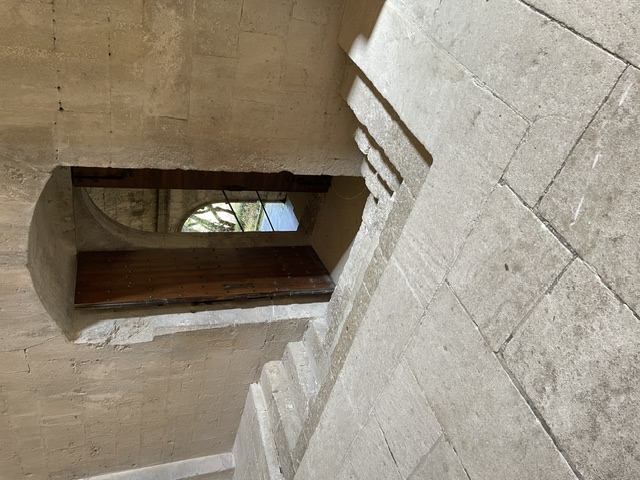
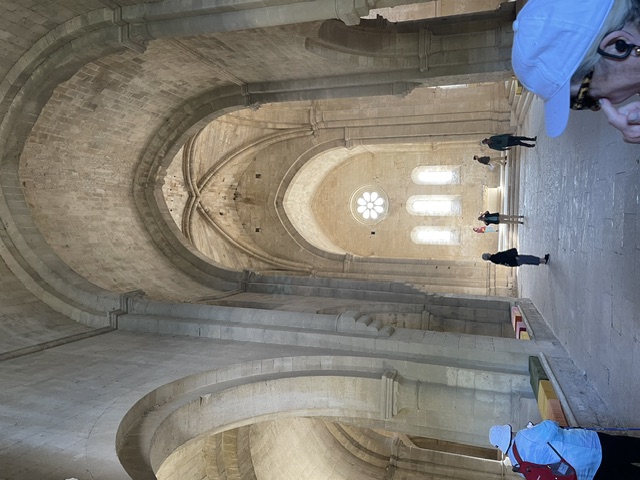
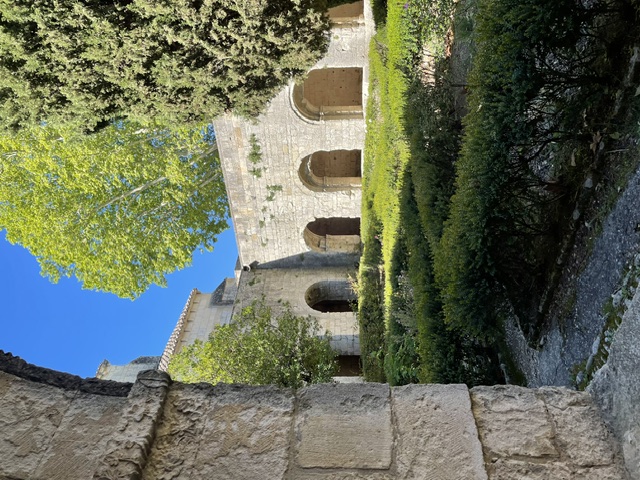
After Silvacane, we boarded our bus to proceed via Cadenet to Lourmarin, which is the resting place of Albert Camus, who died in a car crash near the town on his way back to Paris. Lourmarin is a charming town; cars are banned as the streets are narrow. Since traffic is now prohibited, it has become a lively town of shops, cafes and galleries, with lots of flowers, wonderful doorways and doors and shutters painted in pale shades of lavender and green. It is a great place to stop for a coffee or glass of wine to people watch before heading on to Bonnieux and Roussillon.
The trip to Bonnieux was on a narrow road at the base of a gorge. While the road was two-way, our bus had to proceed slowly as we took up a bit more than one lane. Periodically we stopped to let cars go by us. The gorge was a complete change in fauna and looked more like a New England gorge than the rest of the south of France we had been driving through. As it turns out, the gorge was only a prelude to the very narrow and tortured-hairpin-turn road we would be on to reach Bonnieux. Thanks to the skill of our driver, the bus made it through with all its paint layers. Going through the town, however, we were the dramatic interlude for all the lunch crowd at the local cafes who, we are sure, were taking bets on our ability to get all the way through!
From these tiny old hillside towns, the endless views of the valleys below and the other towns on the adjacent hills are breathtaking. The lavender is not yet in bloom, but the olive trees, vineyards and thousands of bright red poppies are dancing in the beautiful sunlight that only shines this particular way in Provence.
Leaving Bonnieux we went to visit Pont Julien, a Roman bridge built in the time of, and dedicated to, Julius Caesar. We stopped there for a picnic lunch before heading on to Roussillon. (Photos of Pont Julien, and Claire Irving at the adjacent rocks, by Toni Geyelin)
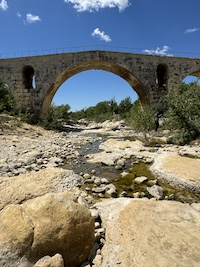
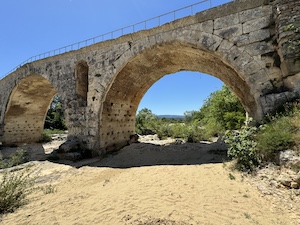
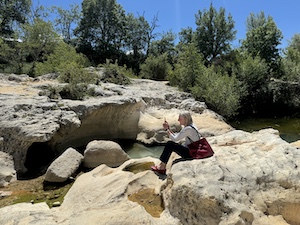
Roussillon is one of the towns in the ochre mining region of France. The town sits high on a hill with splendid views of the valley and of the ochre sedimentary rocks giving rise to the distinct color of all the buildings in the region. The town has also barred traffic from its streets and has endless little shops, galleries and cafes to accommodate its tourist trade. We headed up to the top of the town to enjoy the view and poke into all the shops along the way.
After Roussillon, we were back on the bus to Aix….and a very quiet bus ride it was after all our walking and climbing! We had a lovely dinner that evening at Les Inseparables.
THURSDAY, MAY 9, 2024: AIX-EN-PROVENCE (text by Harry Tether)
(Photos of markets in Aix-en-Provence by Norman Buchan)
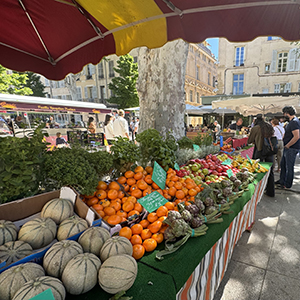

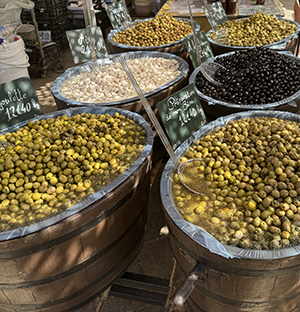
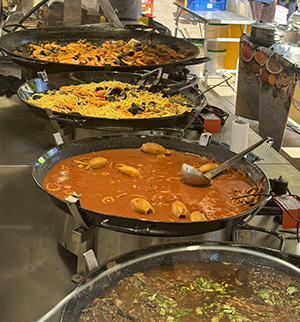
Our last day in Provence began cool and clear. Leaving our well-located Hotel des Augustins with its restored 15th century chapel and cozy lobby, we ventured out in our free time into various markets: the clothes markets along the main boulevard, Cours Mirabeau, and the fish, cheese, flower and saucisson markets on the Place Richelme and Place de l’Hotel de Ville. Aix is a high-class city with few Roman ruins or historic sites, but a wonderful temptation of fancy little shops. Wolf showed us the interior of the cathedral (Église St. Sauveur) and the exterior of the Archbishop’s Palace. Under the Clock Tower was a plaque honoring the U.S. Army 3rd Infantry Division, which, together with the French forces, liberated Aix on August 21, 1944.
We had a beef bourgignon lunch near the Hotel Chaumont. Many of us visited the Bonnard exhibit in the Hotel, which showed the influence of Japan on his painting. A 30-minute film on Cezanne’s life and work was included in the exhibition. Behind the hotel was a delightful little white and blue garden with a boxwood fleur de lis pattern.
After the art outings, there was time to enjoy an Amorino glacé or a last madeleine before packing for the trip home.
[Photos in Aix of Diane and Janin Campos, Ann and Ken Jablon and Kathy and Mike Jiang (with Cezanne), by Kathy Jiang and Harry Tether.]
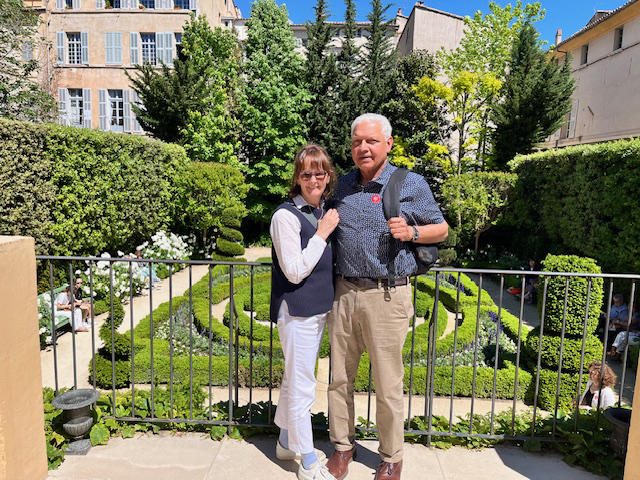
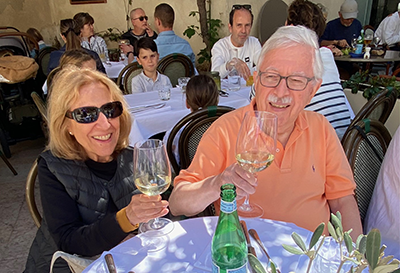
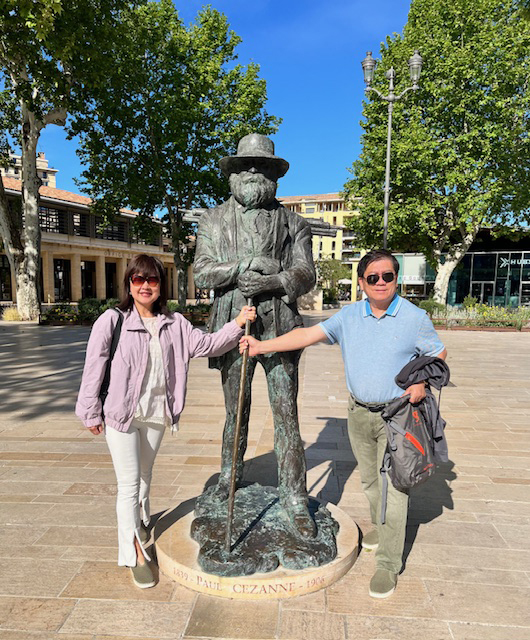
The farewell dinner was around the corner from our hotel, at the Côté Cour. Options of fish (bream?) and lamb were offered, and we all enjoyed dissecting the fussy dessert with a variety of apple flavors.
Au revoir, Aix and Provence!
(Photo of farewell dinner dishes by Mary Tan)
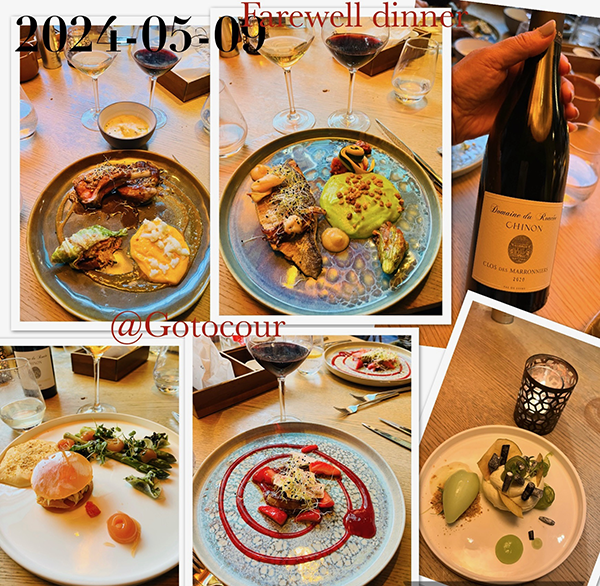
FRIDAY, MAY 10, 2024: DEPARTURES FROM AIX TO AIRPORTS AND TRAINS...AND HOME!
